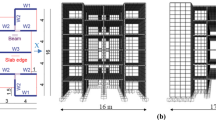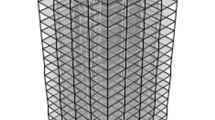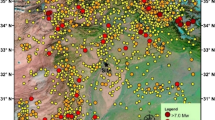Abstract
In the present paper, nonlinear behavior of mass concrete using the smeared crack approach is combined with the Endurance Time Analysis (ETA) method for estimation of probable damages in arch dams when they are subjected to strong ground motions. ETA method is a time-history based dynamic pushover procedure for seismic analysis of structures in which they are subjected to a set of intensifying artificial ground motions called Endurance Time Acceleration Functions (ETAFs). Numerical model of an arch damreservoir-foundation system was excited in maximum credible level using real ground motions and equivalent ETAFs. Cracked areas within the dam body are selected to compare ETA results with conventional nonlinear time-history analysis. Results show acceptable consistency between two methods while using ETA method reduces the total cost of analysis considerably. In addition, continuum seismic performance of dam was evaluated when it’s subjected to ETAFs.
Similar content being viewed by others
References
Alembagheri, M. and Estekanchi, H. E. (2011). “Nonlinear analysis of aboveground anchored steel tanks using endurance time method.” Asian Journal of Civil Engineering, Vol. 12, No. 6, pp. 731–750.
Bayraktar, A., Altuniik, A. C., Sevim, B., Kartal, M. E., Türker, T., and Bilici, Y. (2009). “Comparison of near- and far-fault ground motion effect on the nonlinear response of dam-reservoir-foundation systems.” Nonlinear Dynamics, Vol. 58, No. 4, pp. 655–673.
Bilici, Y., Bayraktar, A., Soyluk. K., Haciefendioglu, K., Ates, S., and Adanur, S. (2009). “Stochastic dynamic response of dam-reservoirfoundation systems to spatially varying earthquake ground motions.” Soil Dynamics and Earthquake Engineering, Vol. 29, No. 3, pp. 444–458.
Calayir, Y. and Karaton, M. (2005). “Seismic fracture analysis of concrete gravity dams including dam-reservoir interaction.” Computers and Structures, Vol. 83, No. 19–20, pp. 1595–1606.
Chopra, A. and Wang, J. (2010). “Earthquake response of arch dams to spatially varying ground motion.” Earthquake Engineering and Structural Dynamics, Vol. 39, No. 8, pp. 887–906.
Du, X. and Tu, J. (2007). “Nonlinear seismic response analysis of arch dam-foundation systems-Part II: Opening and closing contact joints.” Bulletin of Earthquake Engineering, Vol. 5, No. 1, pp. 121–133.
Estekanchi, H. E. and Riahi, H. T. (2010). “Seismic assessment of steel frames with endurance time method.” Journal of Constructional Steel Research, Vol. 66, No. 6, pp. 780–792.
Estekanchi, H. E., Riahi, H. T., and Vafai, A. (2009). “Endurance time method: exercise test as applied to structures.” Asian Journal of Civil Engineering, Vol. 10, No. 5, pp. 559–577.
Estekanchi, H. E., Riahi, H. T., and Vafai, A. (2011), “Application of endurance time method in seismic assessment of steel frames.” Engineering Structures, Vol. 33, No. 9, pp. 2535–2546.
Estekanchi, H. E., Vafai, A., and Valamanesh, V. (2007). “Application of endurance time method in linear seismic analysis.” Engineering Structures, Vol. 29, No. 10, pp. 2551–2562.
Estekanchi, H. E., Vafai, A., and Valamanesh, V. (2010). “Characteristics of second generation endurance time accelerograms.” Scientia Iranica, Vol. 17, No. 1, pp. 53–61.
Hariri-Ardebili, M. A., Kolbadi, S. M., Heshmati, M., and Mirzabozorg, M. (2012). “Nonlinear analysis of concrete structural components using co-axial rotating smeared crack model.” Journal of Applied Science, Vol. 12, No. 3, pp. 221–232.
Hariri-Ardebili, M. A. and Mirzabozorg, H. (2011). “Investigation of endurance time method capability in seismic performance evaluation of concrete arch dams.” Dam Engineering, Vol. 22, No. 1, pp. 35–64.
Hariri-Ardebili, M. A. and Mirzabozorg, H. (2012). “Effects of nearfault ground motions in seismic performance evaluation of a symmetry arch dam.” Soil Mechanics and Foundation Engineering, Vol. 49, No. 5, pp. 192–199.
Hariri-Ardebili, M. A., Mirzabozorg, H., and Estekanchi, H. E. (2011). “Capability of endurance time method in analysis of arch dams and prediction of joints behavior.” Proceeding of the 6 th International Conference in Dam Engineering, Lisbon, Portugal.
Hariri-Ardebili, M. A., Mirzabozorg, H., Ghaemian, M., Akhavan, M., and Amini, R. (2011). “Calibration of 3D FE model of DEZ high arch dam in thermal and static conditions using instruments and site observation.” Proceeding of the 6 th International Conference in Dam Engineering, Lisbon, Portugal.
Hariri-Ardebili, M. A., Mirzabozorg, H., and Kianoush, R. (2012). “A study on nonlinear behavior and seismic damage assessment of concrete arch dam-reservoir-foundation system using endurance time analysis.” International Journal of Optimization in Civil Engineering, Vol. 2, No. 4, pp. 573–606.
Hariri-Ardebili, M. A., Mirzabozorg, H., and Kianoush, M. R. (2013). “Seismic analysis of high arch dams considering contractionperipheral joints coupled effects.” Central European Journal of Engineering, Vol. 3, No. 3, pp. 549–564.
Long, Y., Zhang, C., and Xu, Y. (2009). “Nonlinear seismic analyses of a high gravity dam with and without the presence of reinforcement.” Engineering Structures, Vol. 31, No, 10, pp. 2486–2494.
Mirzabozorg, H., Akbari, M., and Hariri-Ardebili, M. A. (2012). “Wave passage and incoherency effects on seismic response of high arch dams.” Earthquake Engineering and Engineering Vibration, Vol. 11, No. 4, pp. 567–578.
Nozari, A. and Estekanchi, H. E. (2011). “Optimization of endurance time acceleration functions for seismic assessment of structures.” International Journal of Optimization in Civil Engineering, Vol. 1, No. 2, pp. 257–277.
Omidi, O., Valliappan, S., and Lotfi, V. (2013). “Seismic cracking of concrete gravity dams by plastic-damage model using different damping mechanisms.” Finite Elements in Analysis and Design, Vol. 63, pp. 80–97.
Pan, J., Zhang, C., Xu, Y., and Jin, F., (2011). “A comparative study of the different procedures for seismic cracking analysis of concrete dams.” Soil Dynamics and Earthquake Engineering, Vol. 31, No. 11, pp. 1594–1606.
US Army Corps of Engineers (2007). Earthquake design and evaluation of concrete hydraulic structures, EM 1110-2-6053, Washington D.C, USA.
Valamanesh, V. and Estekanchi, H. E. (2012). “Nonlinear seismic assessment of steel moment frames under bidirectional loading via Endurance Time method.” The Structural Design of Tall and Special Buildings, DOI: 10.1002/tal.1054 (Published online first).
Valamanesh, V., Estekanchi, H. E., Vafai, A., and Ghaemian, M. (2011). “Application of endurance time method in seismic analysis of concrete gravity dams.” Scientia Iranica, Vol. 18, No. 3, pp. 326–337.
Wang, H. and Li, D. (2006). “Experimental study of seismic overloading of large arch dam.” Earthquake Engineering and Structural Dynamics, Vol. 35, No. 2, pp. 199–216.
Wang, J. T., Zhang, C. H., and Jin, F. (2012). “Nonlinear earthquake analysis of high arch dam-water-foundation rock systems.” Earthquake Engineering and Structural Dynamics, Vol. 41, No. 7, pp. 1157–1176.
Zhong, H., Lin, G., Li, X., and Li, J. (2011), “Seismic failure modeling of concrete dams considering heterogeneity of concrete.” Soil Dynamics and Earthquake Engineering, Vol. 31, No. 12, pp. 1678–1689.
Author information
Authors and Affiliations
Corresponding author
Rights and permissions
About this article
Cite this article
Hariri-Ardebili, M.A., Mirzabozorg, H. Estimation of probable damages in arch dams subjected to strong ground motions using endurance time acceleration functions. KSCE J Civ Eng 18, 574–586 (2014). https://doi.org/10.1007/s12205-013-0264-6
Received:
Accepted:
Published:
Issue Date:
DOI: https://doi.org/10.1007/s12205-013-0264-6




